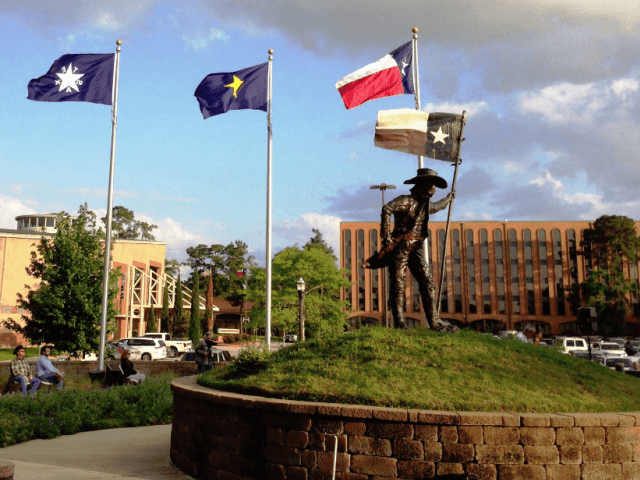The latest U.S. Census Bureau figures released Thursday reveal that Texas dominates the top five fastest-growing cities in the nation.
In their annual rankings, the bureau looked at municipalities with populations of 50,000 or more and Lone Star State suburbs won big in the period from July 1, 2015 to July 1, 2016.
The Houston suburb of Conroe took the top spot as the nation’s fastest growing city, increasing in population by 7.8 percent to 82,286 during that time frame, making its growth rate more than 11 times higher than the national average of 0.7 percent. Among the regional draws are high-tech companies and a 385-acre Exxon Mobil corporate campus that opened south of Conroe in 2015.
Two sprawling suburbs north of Dallas, Frisco and McKinney, placed second and third, respectively. Frisco, which spans over Collin and Denton counties, experienced a 6.2 percent population boom upping its number of residents to 163,656. Last year, the Dallas Cowboys moved their headquarters from another adjacent suburb, Irving, to Frisco, where the team built its new headquarters and practice facility on an expansive campus that includes team offices and a spa. The Dallas Stars also are based in Frisco. Breitbart Texas reported Frisco placed fourth last year’s list of fastest-growing U.S. cities.
Neighboring McKinney, which Money Magazine dubbed the “Best Place to Live in America” in 2014, saw its population grow to 172,298, a 5.9 percent increase.
Frisco and McKinney benefit from Toyota moving its North American headquarters from Torrance, California, to another nearby suburb, Plano. Starting May 15, the Japanese automaker began to bring around 250 of their transplanted employees a week onto its new 100-acre, $3 billion Legacy West business park where ultimately 4,000 employees will work. Also influencing the influx of new residents are the dozens of other corporations setting up shop like State Farm, Kubota Tractor, Jamba Juice, and McKesson Corporation.
Texas officials have attributed this explosive growth to a diversified economy no longer solely dependent on oil and gas. Breitbart Texas reported the state’s good quality of life, business-friendly policies, and incentives like the Texas Enterprise Fund help in making Texas attractive to companies whether they relocate their home bases or expand regional facilities with the goal of creating more jobs and economic growth within the state.
In the Austin area, Georgetown ranked fifth on the list. It grew its people by 5.5 percent to 67,140. Last year, Georgetown led the nation as the fastest growing U.S. city with a 7.8 percent increase that bumped its inhabitants up to 63,716, Breitbart Texas reported.
Other Texas suburbs made the top 15. New Braunfels, in the San Antonio area, placed ninth with a 4.7 percent increase to 73,959 people. Cedar Park, part of the Austin-Round Rock metro region, ranked 12th, upping its number of residents 4.5 percent to nearly 69,000 people.
Also, in Texas, League City, located between Houston and Galveston, was the only U.S. city to cross 100,000 population mark during the reporting period, reaching 102,010.
The Census Bureau says 10 of the 15 fastest-growing large U.S. cities were in the South. They continue to grow at a faster rate than any other U.S. region. No northeast cities ranked among the nation’s fastest growing.
“Since the 2010 Census, the population in large southern cities grew by an average of 9.4 percent. In comparison, cities in the West grew 7.3 percent, while cities in the Northeast and Midwest had much lower growth rates at 1.8 percent and 3.0 percent respectively,” said Amel Toukabri, a demographer in the Census Bureau’s population division.
[Source: U.S. Census Bureau]
Greenville, South Carolina, was the only city outside of Texas to crack the top five. The city ranked fourth, with a 5.8 percent growth spurt and bringing its population to 67,453.
Four western cities made the top 15: Bend, Oregon, in sixth place; Buckeye, a Scottsdale, Arizona suburb, took seventh, making a 4.8 percent leap from 62,138 to 64,629 residents. Last year, Buckeye placed 15th on this list. Lehi, Utah, came in 11th and Meridian, Idaho, took 13th. The lone Midwestern contender, Ankeny, Iowa, took 14th place. The Nashville-area Murfreesboro in Tennessee, a city of nearly 132,000 people, made 10th place.
Two Floridian cities also made the list. Bonita Springs in the Fort Myers area ranked eighth, touting a 4.8 percent increase and a population of 54,198; while Fort Myers sported 15th place, with a 4.5 percent boost that grew its headcount to 77,146.
New York remains the nation’s largest city by a wide margin with 8.5 million people, making it twice as large as the second largest city Los Angeles, which maintains a population of roughly 4 million. Chicago took third, with 2.7 million residents, despite a population loss of 8,638. Phoenix, however, had the largest numeric increase of inhabitants of any U.S. city, adding 32,113 or roughly 88 people per day on average between 2015 and 2016.
Follow Merrill Hope, a member of the original Breitbart Texas team, on Twitter.


COMMENTS
Please let us know if you're having issues with commenting.